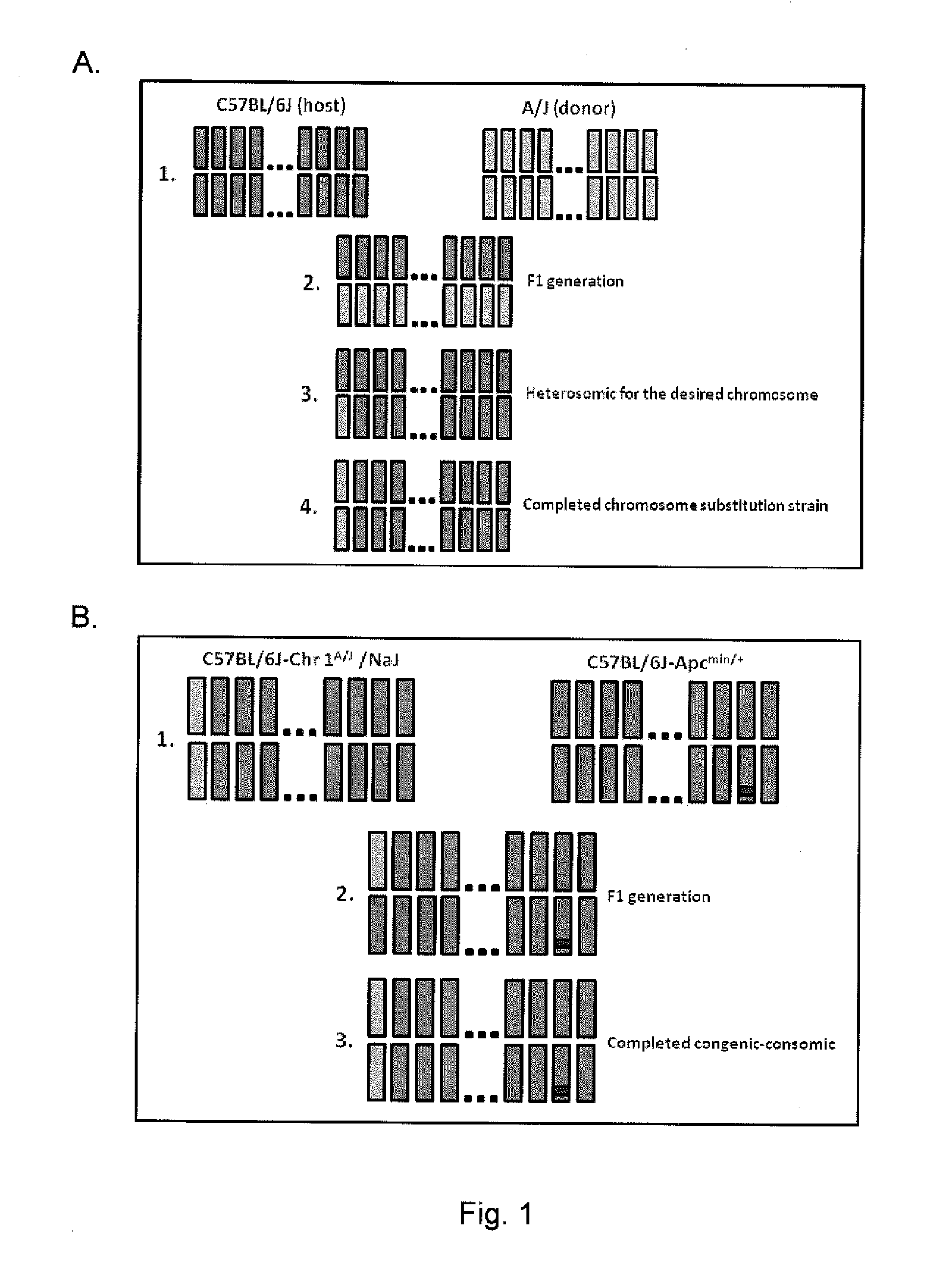Treatment of colon cancer using complement inhibitors
a complement inhibitor and colon cancer technology, applied in the field of oncology and cancer therapy, can solve the problems of difficult evaluation of the independent contributions that each makes to the development and progression of colon cancer, and the distinct role of the complement system in colon cancer has not been elucidated, so as to prevent one or more polyps from growing, preventing, reducing or delaying the growth of polyps, and preventing the formation of polyps
- Summary
- Abstract
- Description
- Claims
- Application Information
AI Technical Summary
Benefits of technology
Problems solved by technology
Method used
Image
Examples
example 1
[0084]This example describes animals and diets utilized in the subsequent examples.
[0085]Mouse Models
[0086]Two mouse models were combined to create a novel model system. The first model was an intestinal cancer susceptible strain, B6.ApcMin / + (Min=Multiple Intestinal Neoplasia), that closely resembles aspects of the human disease. The second was a set of strains, the Chromosome Substitution Strains (CSSs), which have contrasting responses to a high fat diet. These CSSs were used to construct congenic-consomic strains (CCSs) that are susceptible to colon cancer, but are either resistant or susceptible to diet-induced obesity, depending on the CSS.
[0087]B6.ApcMin / + is a mouse model for intestinal neoplasia that carry a mutation in the Apc gene similar to that found in over 85% of sporadic colon cancer cases in humans. The APC mutation results in improper binding of β-catenin to the degradation complex and models the mutation observed in most sporadic human colon cancer tumors. B6.ApcM...
example 2
[0098]The experiments described in this example show the effect of diet versus obesity on intestinal cancer susceptibility. After 60 days on the diet described in Example 1, polyp numbers and sizes in lean and obese CCSs were analyzed. All mice fed the HFCoco diet had a significant increase in polyp number compared to mice fed the LFCoco diet, regardless of susceptibility to diet-induced obesity. The obesity-susceptible A2.ApcMin / + had a 3.6-fold increase in polyp number when fed the HFCoco diet, compared to mice fed the LFCoco diet, which was similar to the 3.6-fold increase observed in B6.ApcMin / + fed the same diet. This same trend was detected in the lean CCSs A7.ApcMin / + and A17.ApcMin / + where a 3.0 and 3.4-fold increase was observed, respectively. These findings suggest that obesity is not crucial for polyp development and puts more emphasis on the importance of dietary effects on disease. If obesity were crucial for polyp development, it would have been expected to see an incr...
example 3
[0101]To test the effect of high dietary fat on inflammatory mediators and Wnt signaling, male B6.ApcMin / + were fed diets high or low in coconut or corn oil for 30 days. B6.ApcMin / + mice were put on diets high or low in omega-6 polyunsaturated fatty acids (HFCorn, LFCorn) or saturated fat (HFCoco, LFCoco) for 30 days. The HFCorn diet has a 30:1 omega-6 to omega-3 ratio, which closely mimics the ratio seen in most Western diets. At the end of the diet study, wild-type tissue from the intestine was collected from wild-type controls, whereas normal and polyp tissues (sized-matched) were extracted from all B6.ApcMin / + mice. Samples were immediately frozen in liquid nitrogen after extraction and stored in a freezer (−80° C.) until analyzed. Tissues were used to extract protein and RNA using radioimmunoprecipitation assays and the QIAGEN RNeasy Mini Kit, respectively. Wild-type, normal tissue from Apc mutants, and polyp tissue were used to extract mRNA or protein for analysis of COX-2, IL...
PUM
| Property | Measurement | Unit |
|---|---|---|
| size | aaaaa | aaaaa |
| pharmaceutical composition | aaaaa | aaaaa |
| area | aaaaa | aaaaa |
Abstract
Description
Claims
Application Information
 Login to View More
Login to View More - R&D
- Intellectual Property
- Life Sciences
- Materials
- Tech Scout
- Unparalleled Data Quality
- Higher Quality Content
- 60% Fewer Hallucinations
Browse by: Latest US Patents, China's latest patents, Technical Efficacy Thesaurus, Application Domain, Technology Topic, Popular Technical Reports.
© 2025 PatSnap. All rights reserved.Legal|Privacy policy|Modern Slavery Act Transparency Statement|Sitemap|About US| Contact US: help@patsnap.com



